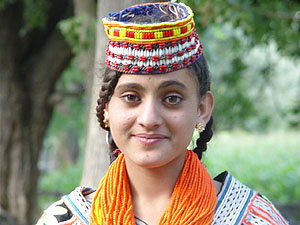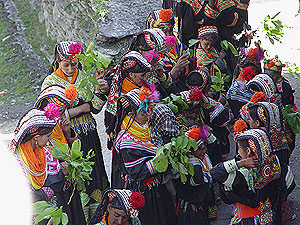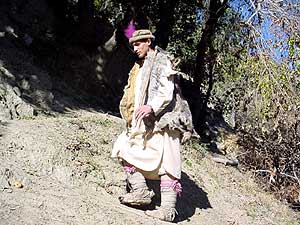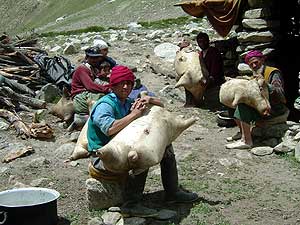Kalash
 The Kalash tribe, numbering approximately 3,000, are the smallest group amongst the religious minorities of Pakistan. Unlike the other minorities, they live exclusively in a particular geographical area; the three valleys of Birir, Bumburet and Rumbur known locally as Kafirastan. Kafirastan is situated in the Hindu Kush between the Afghan border and Chitral valley. Until 1896 Kafiristan also included present day Nuristan in Afghanistan, inhabited by the ‘Red Kafirs’, whereas the Kalash were called the ‘Back Kafirs’.
The Kalash tribe, numbering approximately 3,000, are the smallest group amongst the religious minorities of Pakistan. Unlike the other minorities, they live exclusively in a particular geographical area; the three valleys of Birir, Bumburet and Rumbur known locally as Kafirastan. Kafirastan is situated in the Hindu Kush between the Afghan border and Chitral valley. Until 1896 Kafiristan also included present day Nuristan in Afghanistan, inhabited by the ‘Red Kafirs’, whereas the Kalash were called the ‘Back Kafirs’.
Kalash myths tell that they originally came from Tsiam, thought to be near Yarkand. The Kalash oral tradition also tells that the Kalash are descended from Alexander the Great’s brave general Shalak Shah of Tsiam,  to whom Alexander gave the Chitral valley as a reward. Kalasha language is of great interest to linguists as it belongs to the ancient Dardic branch of the Indo-European languages, suggesting a Central Asian origin. Around 1500 AD the Kalash were dominant throughout southern Chitral; the Kalasha oral tradition mentions eight great Kalasha kings. Local people outside the valleys often find remnants of buildings revealing evidence of former Kalash settlements.
to whom Alexander gave the Chitral valley as a reward. Kalasha language is of great interest to linguists as it belongs to the ancient Dardic branch of the Indo-European languages, suggesting a Central Asian origin. Around 1500 AD the Kalash were dominant throughout southern Chitral; the Kalasha oral tradition mentions eight great Kalasha kings. Local people outside the valleys often find remnants of buildings revealing evidence of former Kalash settlements.
When the Kalash migrated from Nuristan in 1896 under threats from Afghan King Abdur Rehman , they found the Chitralis much more tolerant & peaceful .. The refugees were given land by the Chitrali ruler Aman ul Mulk in the upper parts of the Kalash valleys which they possess to this day and were allowed to practice their beliefs protected in Chitral.
The Nurastani
 The Nuristani tribe are a proud race living in the Hindukush Mountain in northern Afghanistan along the Chitral border. This is a world of extreme isolation in the remotest corner of the Hindukush where caravan routes passed to the east and west of the area avoiding it, with only one road a dirt track leading halfway up the Bashgal valley.
The Nuristani tribe are a proud race living in the Hindukush Mountain in northern Afghanistan along the Chitral border. This is a world of extreme isolation in the remotest corner of the Hindukush where caravan routes passed to the east and west of the area avoiding it, with only one road a dirt track leading halfway up the Bashgal valley.
This tribe enjoyed centuries of independence living as warriors and hunters, first with spear and bow and later with rifles. For eight or nine centuries they held out against the tide of Islam, raiding Muslim settlements and caravans until at the end of the last century they came under the suzerainty of Afghanistan. The original name of Kafirastan 'land of the infidels' was then changed for Nuristan.
 Their way of life, architecture, traditional culture and language are remnants of the former Red Kafir traditions . They still live in villages of 100 to 200 wooden houses remarkable both inside and out for neatness and cleaness, are clustered together, clinging precariously to the steep- sided valleys , the women still till their fields by hand, while the men look after their live stock and irrigation channels.
Their way of life, architecture, traditional culture and language are remnants of the former Red Kafir traditions . They still live in villages of 100 to 200 wooden houses remarkable both inside and out for neatness and cleaness, are clustered together, clinging precariously to the steep- sided valleys , the women still till their fields by hand, while the men look after their live stock and irrigation channels.
They breed cattle sheep and all their agricultural products are of fine quality, their cattle which in appearance and size compare favourably with English breeds are much sought after by their neighbours.